California Zephyr
Preface
This is my attempt at reviewing the California Zephyr in the style of John Green’s The Anthropocene Reviewed. Also, trigger warning for illness, death, and depression.
The California Zephyr
In 1848, 150 years before my Chinese parents immigrated to the United States, a carpenter named James Marshall was building a sawmill on the American River in Northern California. The tale goes that on the morning of January 24th, he noticed a shiny glimmer along the river bed. That glimmer was a piece of gold, and his discovery triggered the California Gold Rush of 1849. The historical site of that mill is now the Marshall Gold Discovery Historic Park, which is only a 30-minute drive from Folsom, a town 20 miles northeast of Sacramento and my childhood home.
Mankind’s fascination for gold long predates the 1848 Gold Rush. An ancient civilization in present-day Bulgaria created decorative gold artifacts by 4000 BCE, and the Iron Age kingdom of Lydia minted the first purely gold coin around 550 BCE. Gold is of course valued for its rarity and beauty. But unlike silver, copper, or iron–which tarnish, corrode, and rust–gold is chemically inert; its beauty persists, making it a brilliant (pun-intended) choice for jewelry and coins.
News of that bewitchingly beautiful gold spread like wildfire, and people from around the US and the world converged onto California in one of the largest human migrations in American history. Notably, the Gold Rush was marked by the first major wave of Chinese immigrants to the US, and over 300,000 Chinese people came to the West Coast by 1882. One of the Chinese names for San Francisco to this day is 旧金山 (Jiùjīnshān)–“Old Gold Mountain.”
The sacrifices made by these Chinese immigrants were innumerable. Most immigrants were men, and although more than half were married, very few came with their wives and families. Many were never reunited with their loved ones. A Chinese folk song at the time goes:
In the second reign year of Haamfung*, a trip to Gold Mountain was made.
With a pillow on my shoulder, I began my perilous journey.
Sailing a boat with bamboo poles across the seas,
Leaving behind wife and sisters in search of money,
No longer lingering with the woman in the bedroom,
No longer paying respect to parents at home.
* aka the Xianfeng Emperor, year 1852
Chinese immigrants also faced intense racial discrimination. Laws such as the Foreign Miners’ Tax specifically targeted Chinese miners. 18 Chinese men were lynched in Los Angeles during the Chinese Massacre of 1871. In 1882, the Chinese Exclusion Act ended Chinese immigration and prevented immigrants already in the country from becoming citizens. Restrictions were not lifted completely until the Civil Rights Movement spurred the passage of the Immigration and Nationality Act of 1965. Afterward, immigration from China steadily increased, and by the time my parents landed in Iowa in 1998, they were two of nearly 50,000 Chinese newcomers to the US that year.
The first wave of Chinese immigrants made a myriad of contributions to American society. Notably, they helped connect the nation when 14,000 Chinese workers were hired to build the first Transcontinental Railroad.
The railroad was first proposed in 1845 by Asa Whitney in response to America’s westward expansion. The project did not begin in earnest until 1861 when President Lincoln signed the Pacific Railroad Act. The Central Pacific Railroad Company built the line eastward starting from Sacramento, California. At the same time, the Union Pacific Rail Company laid tracks westward starting from Council Bluffs, Iowa. While the Union Pacific mostly hired Irish immigrants and Civil War veterans, around 80% of the Central Pacific Workers were Chinese. Many paid a heavy price for their efforts. While no official records exist on the death toll from working on the railroad, the remains of Chinese immigrants were often returned to China per traditional beliefs about the burial of bodies in one’s home village. 20,000 pounds of bones were shipped back to China during the construction of the railroad–an estimated toll of 1,200 workers. Thanks to the sacrifice and hard work of these Chinese laborers, the transcontinental railroad was finally completed in May 1869.
In the present day, rail travel has declined massively as most travelers opt for cars or planes. Nevertheless, Amtrak, the American national railroad company, still had 22.9 million riders in 2022. One of their most famous lines is the California Zephyr. Operating between Chicago and San Francisco, the train still follows the route of the original Transcontinental Railroad for parts of the journey. In April 2023, my friend Danny and I took the 50-hour trip on the California Zephyr from my home in Chicago to my hometown in Folsom, California.
We boarded the train around 1 pm at Union Station in downtown Chicago (as an aside, I recently learned that Union Stations were stations that were served by multiple train companies, which is why the main train stations in many large cities bear that name). As part of our ticket, we had access to the Amtrak Lounge and its complimentary snacks while we waited for our train to board.
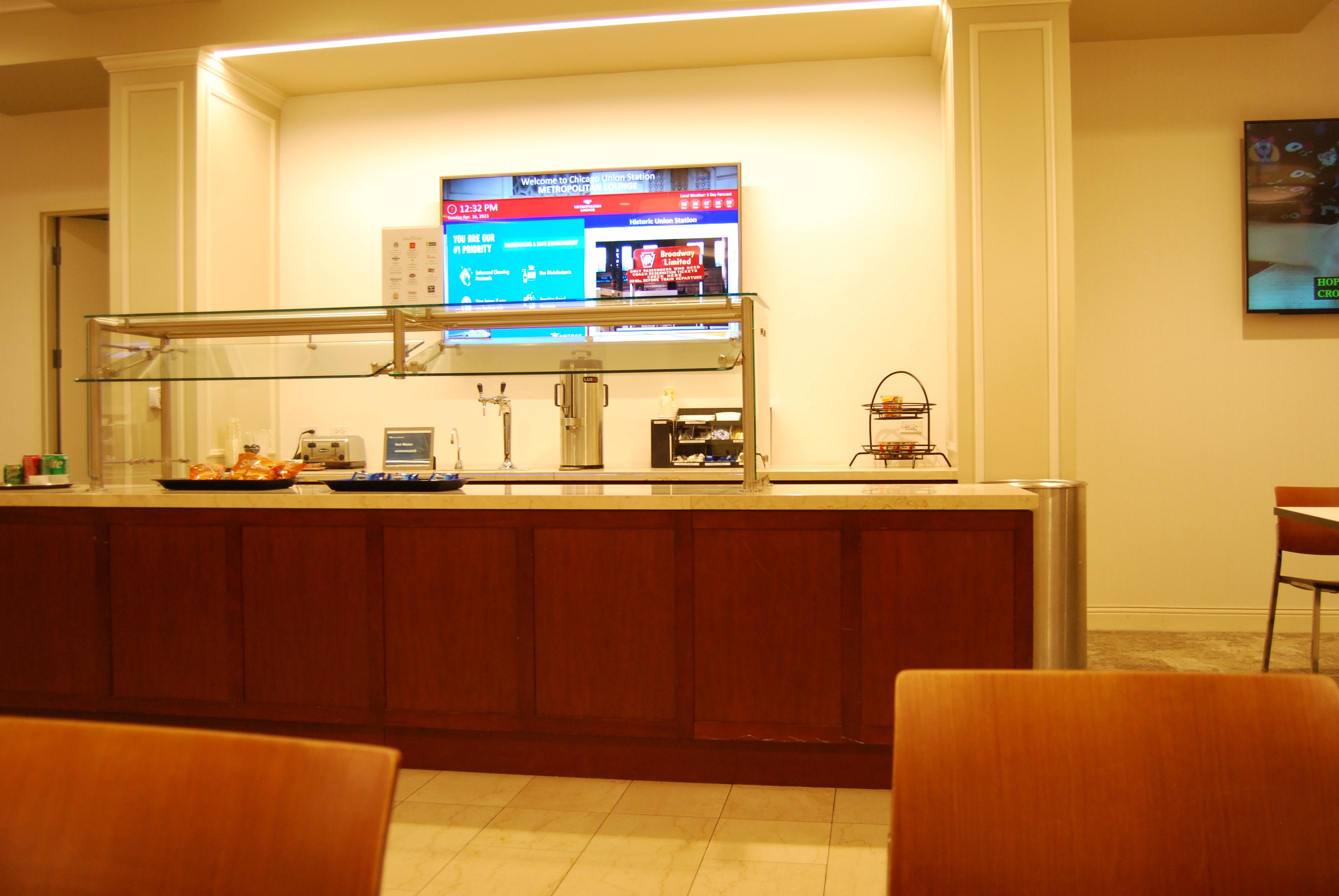
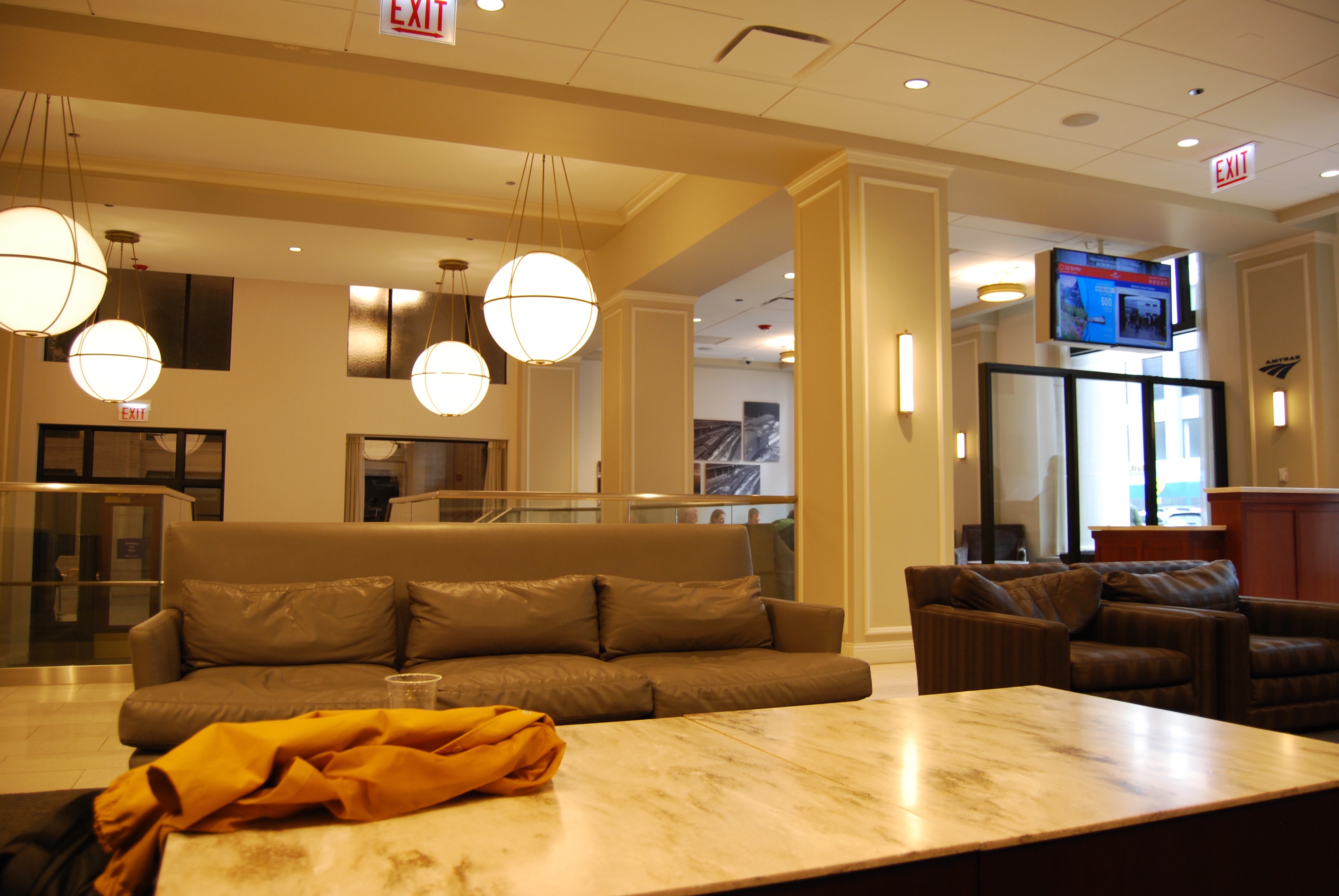
After getting on the train, we settled into the small roomette that would be our home for the duration of the trip. The room had two large seats that faced each other. At night, the seats reclined downwards and combined to form a bed. A second bed was folded open from above. We had access to public bathrooms and showers in our car. Shortly after being seated, our room attendant introduced himself to us, and another attendant from the dining car came to take our dinner order.
Our ticket included three meals a day. While the timings for breakfast and lunch were flexible, dinners needed to be reserved in advance. The food was surprisingly good. The dinners were three courses and included one alcoholic drink. The first night, I got coconut-crusted shrimp, Amtrak’s signature railroad flat iron steak, a cheesecake, and a glass of Chardonnay. Other entree options included chicken breast and salmon, but I’ll admit that Danny and I ordered the steak both nights.
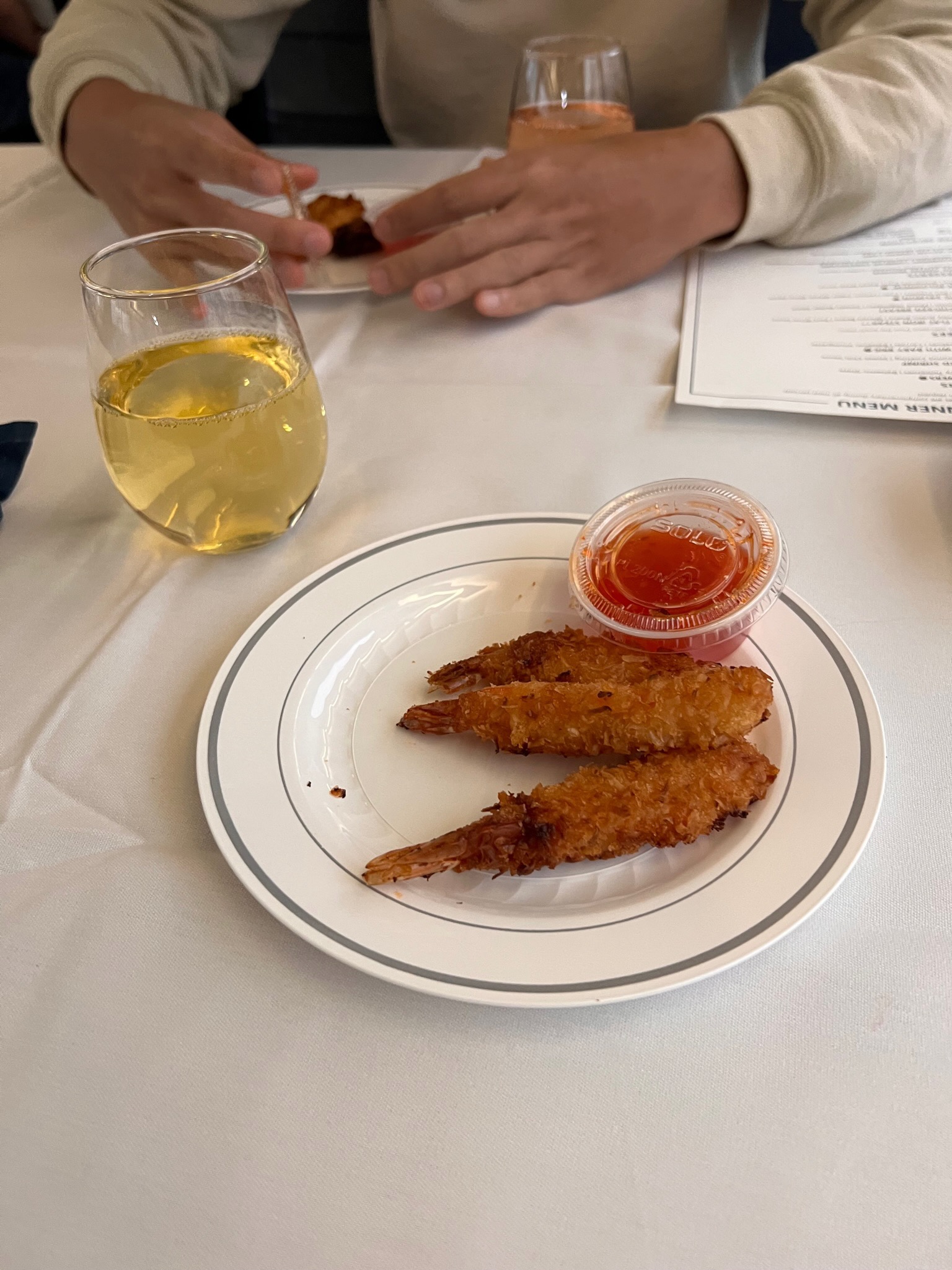
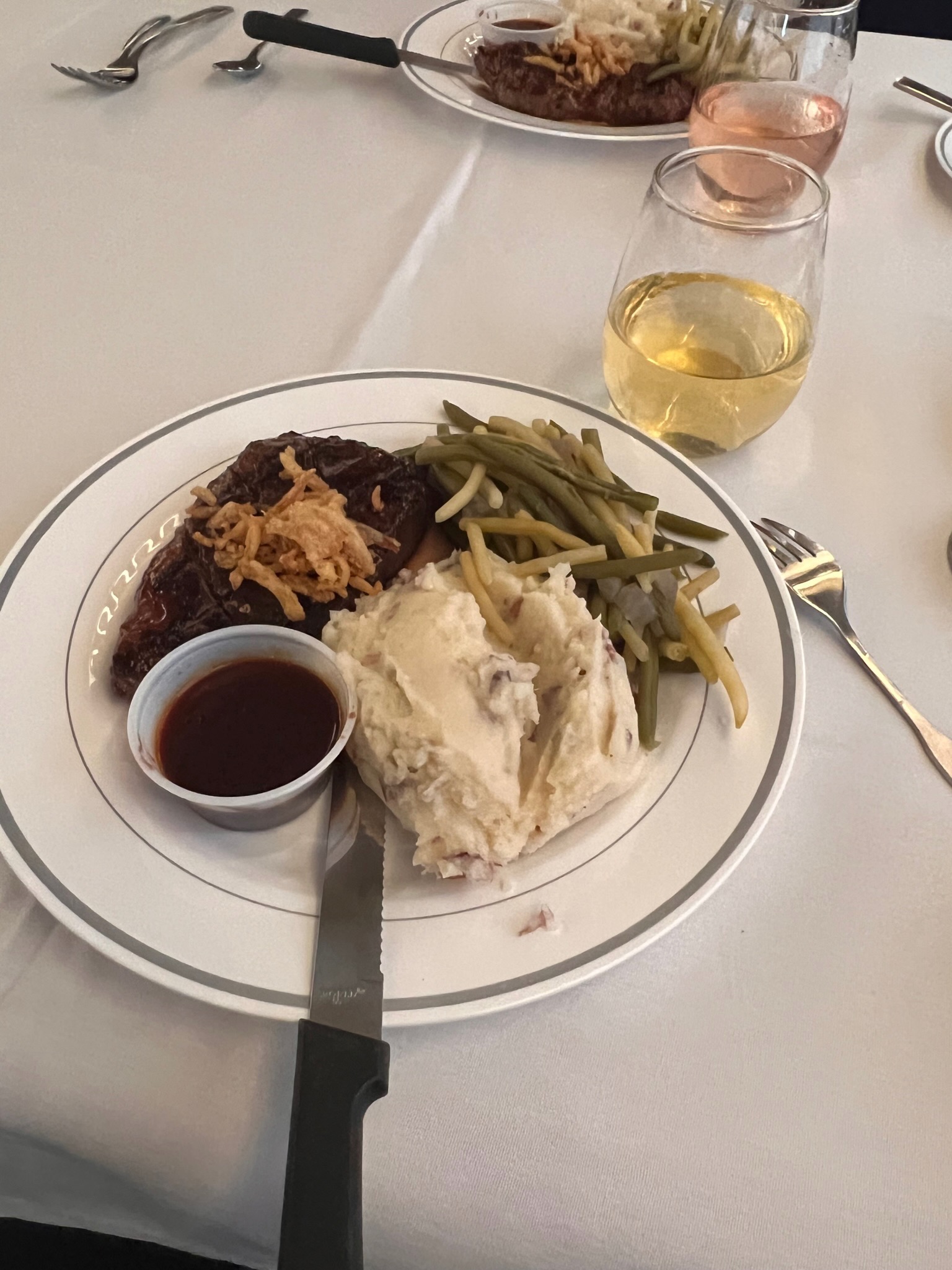
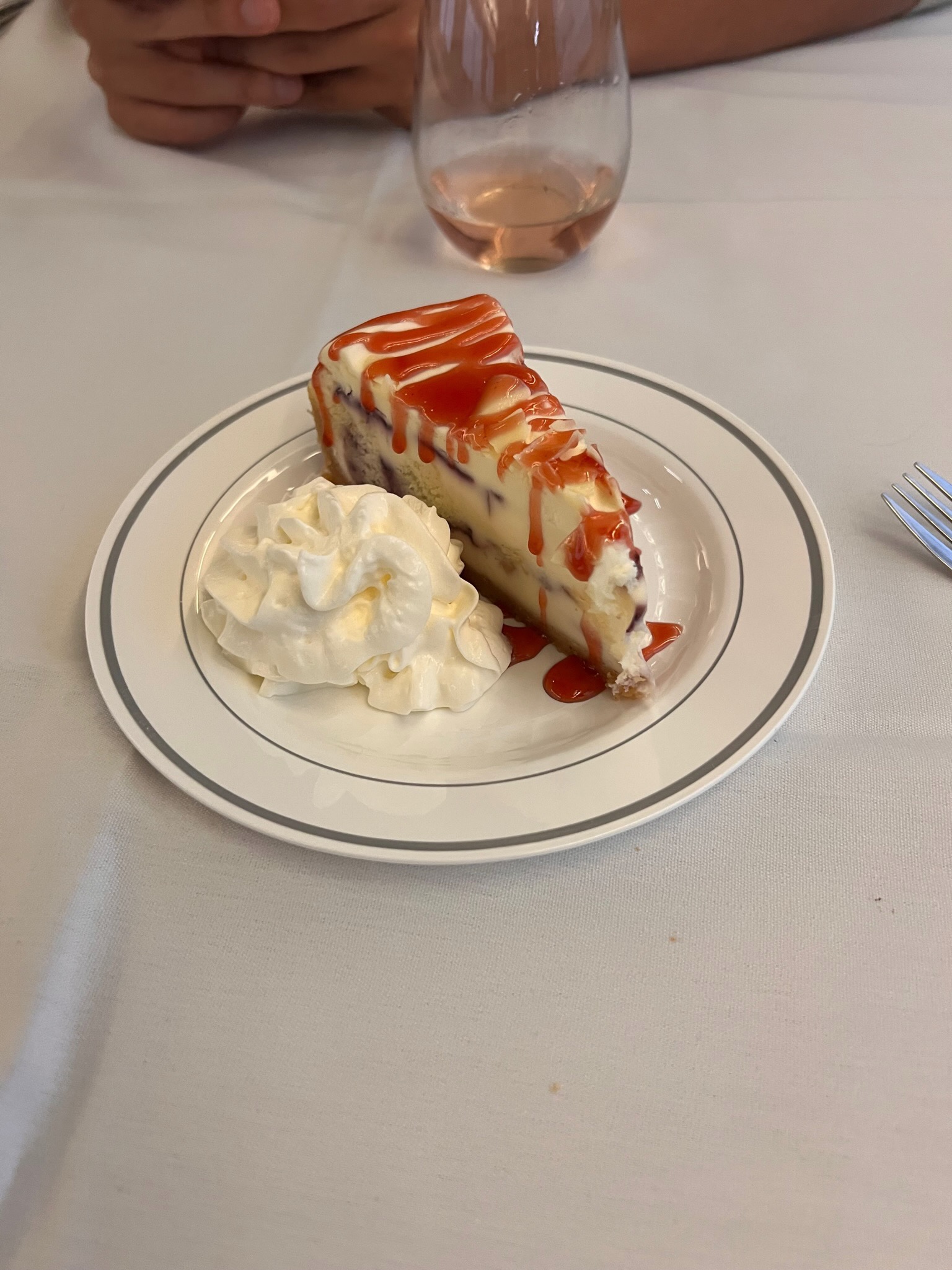
The breakfast was also quite good and included options such as omelets, breakfast quesadillas, and French toast. The lunch could have been better, and I tried their average-tasting grilled sandwich and beef burger during my couple of midday meals onboard.
Because seating was limited in the dining car, two separate parties were often put together at a single four-person table. By chance, Danny and I spent several meals with the same retired couple from Newcastle, England, so we had ample time to chat with them throughout the trip. Mae and James, the couple in question, were delightful and interesting people. James, the husband, had a PhD in chemistry and worked at a pharmaceutical company before retiring. His greeting towards us–“Good day boys”–was remarkably consistent and endearing. I enjoyed chatting with him about science, politics, and (European) football.
Mae, the wife, referenced her career occasionally, but she preferred regaling us with stories related to her volunteering/charitable work, which was clearly much more important to her. Over dinner, while passing through the Utah desert, she described her first trip to the United States with a foster child. On a whim, they decided to drive into the barren landscape of Death Valley, the memories of its magnificence evoked by a similarly stunning panorama outside the dining car window. She also told us about a boy–now an adult–who escaped Sudan during its civil war and was taken up by her and other members of her church. Separated from his siblings and mother, he struggled a lot to adapt to living in Britain. Mae’s story had a happy ending. Although for many years, the boy had completely lost contact with his family, he recently reconnected with his mother, who had survived the horrific violence of the war and its aftermath. The story left off with his current attempts to bring her to the UK.
What a cool couple! I admit, I was initially unenthusiastic about sharing dining tables with random travelers. However, I feel fortunate to have crossed paths with people such as Mae and James and to hear their stories, even if only for a few meals.
While not sleeping or eating, I spent almost the entire trip in the lounge car, which had tables and giant windows that wrapped up onto the ceiling. I was studying (read: cramming) for STEP 1, a board exam for medical students, so I was watching videos and doing flashcards all day. Nevertheless, I tried to look up and appreciate the breathtaking scenery outside the large windows. The views were incredibly varied across the trip; the train passed through the Great Plains, the Rocky Mountains, the desert plateaus of Utah, and the Sierra Nevadas, before descending into the Central Valley of California. Below is a small sample of the sights we saw–definitely not the worst place to be studying for an exam!
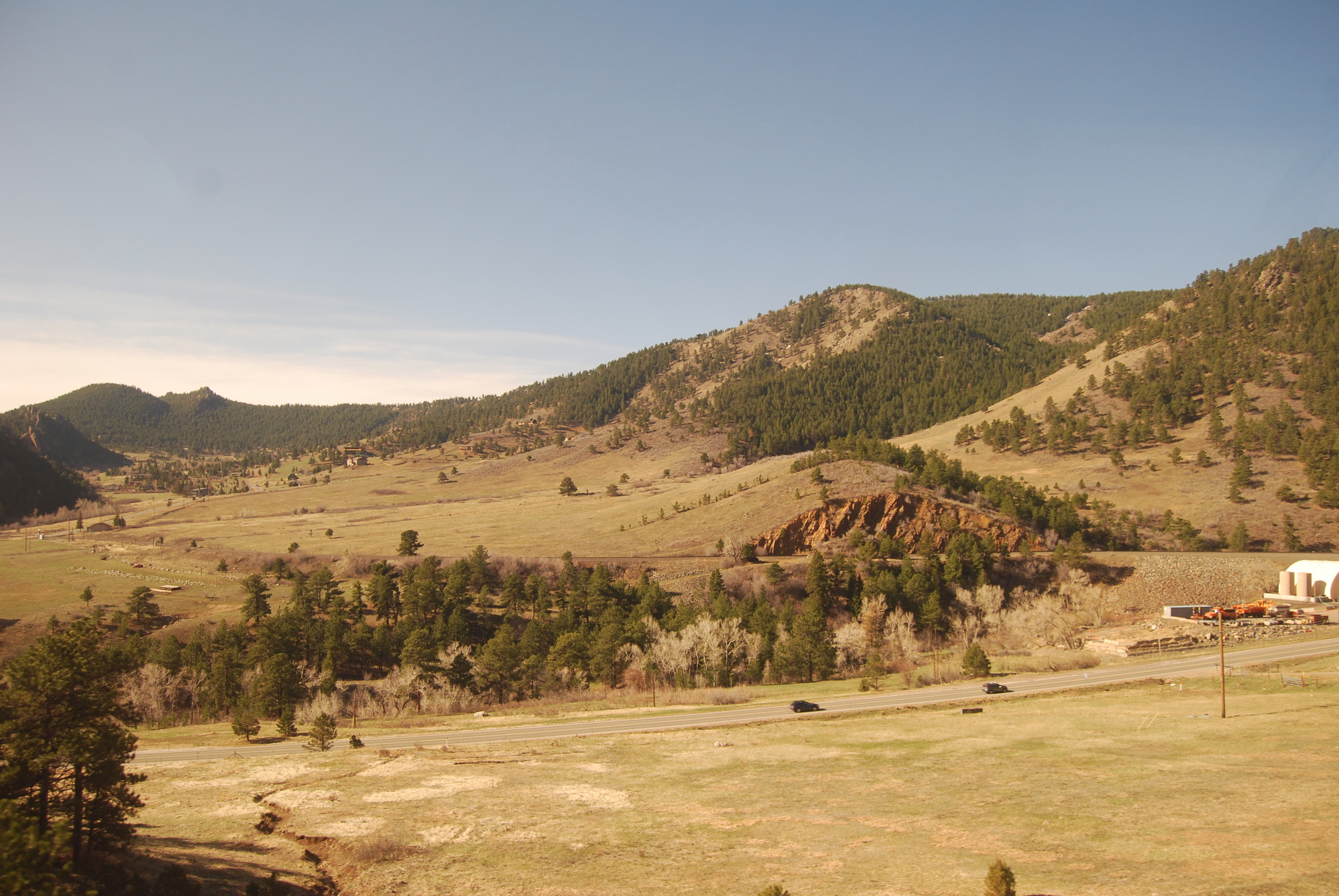
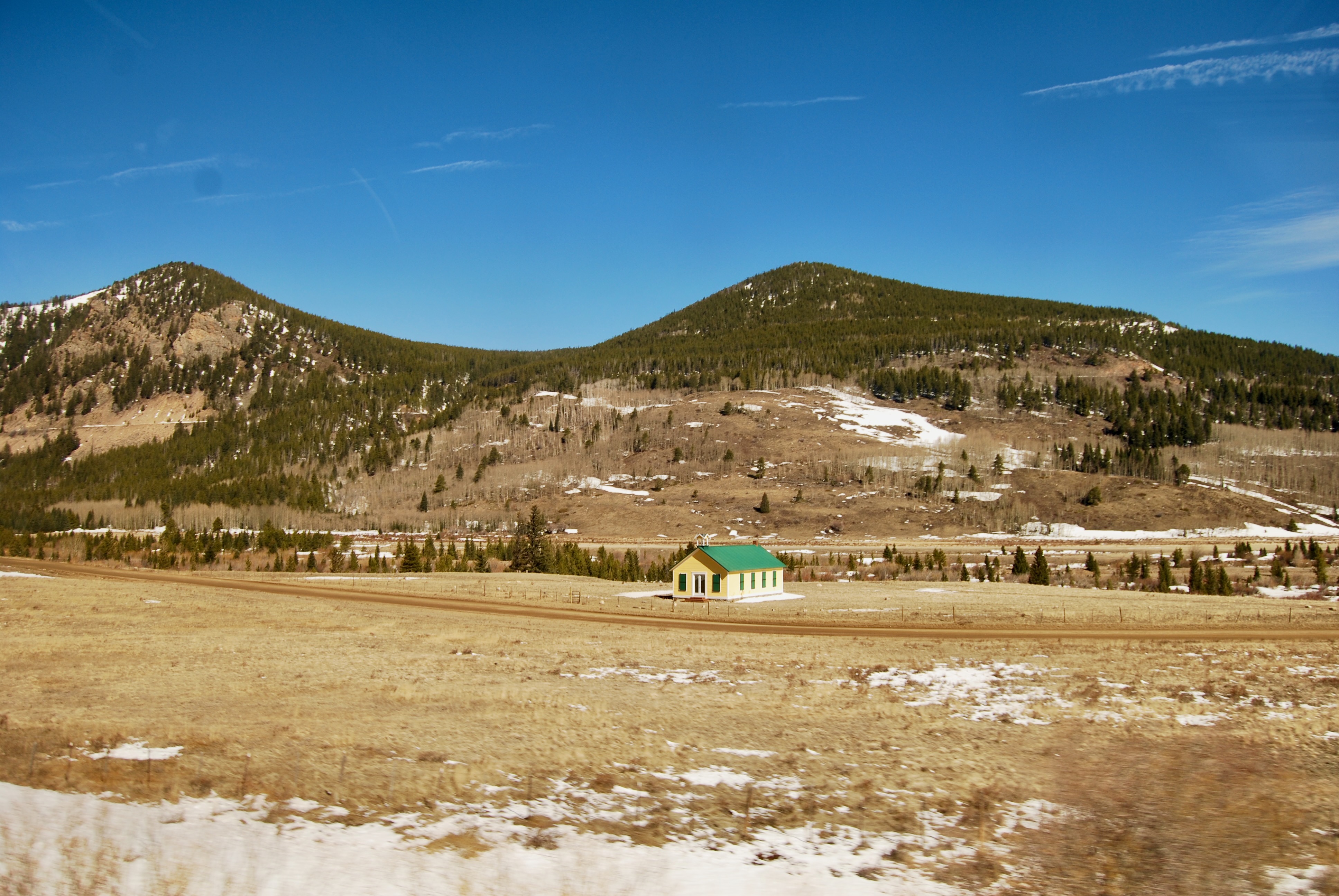

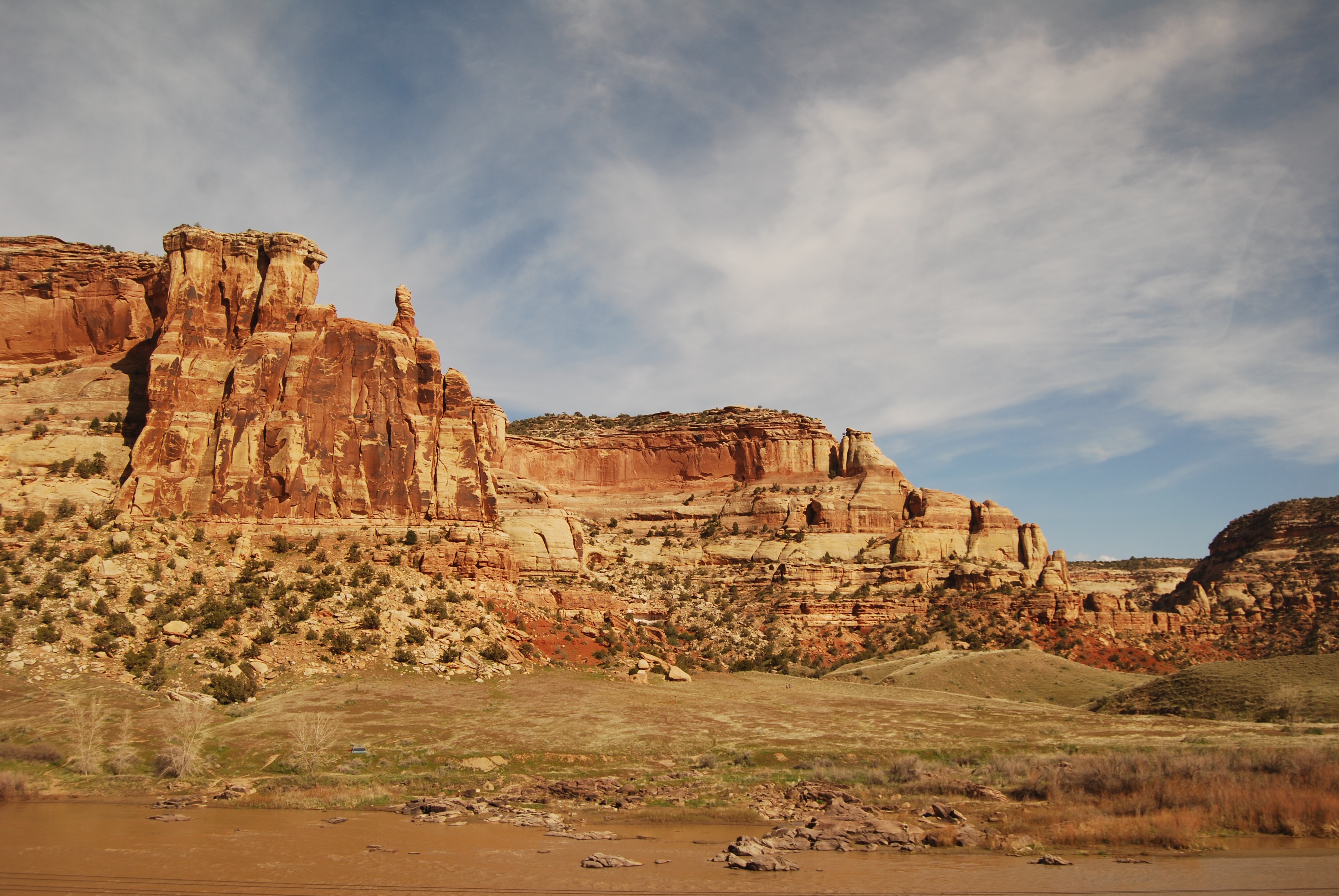
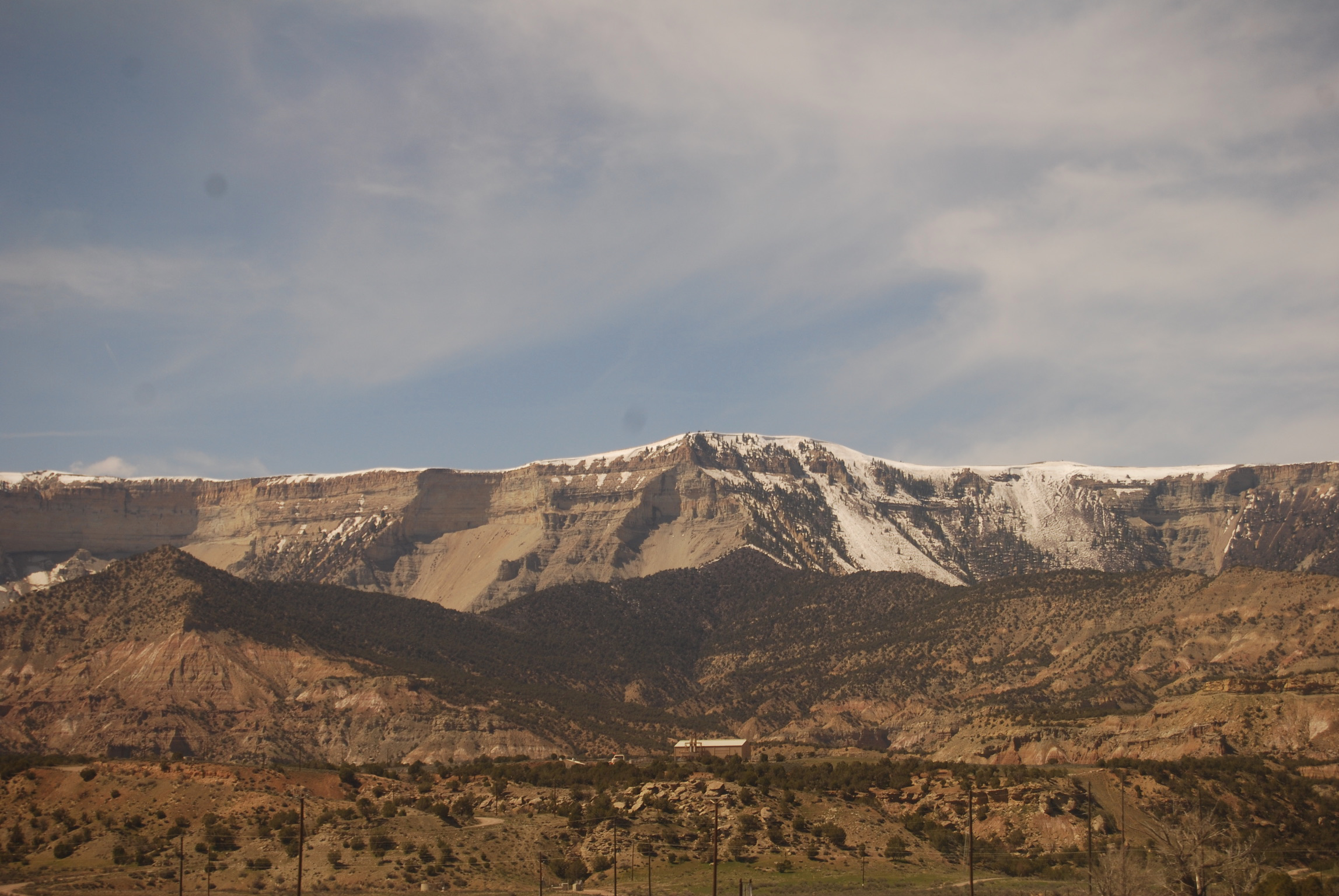

The thing about sightseeing from an Amtrak train is that the panoramas fly by pretty quickly. We passed through towns in what felt like an instant. Most stops were less than five minutes. The landscape ceaselessly and rapidly rolled by; the mountains we saw in the distance enlarged until they surrounded the train before swiftly fading away behind us. The conductor occasionally used the intercom to highlight points of interest, especially during a particularly scenic stretch through a gorge in the Rocky Mountains, but if we blinked or were away from the window, we missed them.
I think the ever-changing views outside the train windows reflected the feelings inside of me. At the time, I was going through major life transitions and personal struggles, so I was inundated with a profound sense of loss. Less than a year before the trip, in June 2022, my mom was diagnosed with stage 4 cancer. After months of chemotherapy, she was scheduled for surgery a few weeks after my arrival to remove the tumors in her stomach and liver. I was taking the train to spend the next six months at my parents’ home to help her recover. The grief I felt for my mom’s health was overwhelming. Life felt so short; she wasn’t even 50 years old yet when we first found out, and I despaired at the uncertainty of the time left we had together. My grief for my family was compounded a few months after my mom’s initial diagnosis when my maternal grandma passed away after falling down the stairs. For many months after that June, I was severely depressed. It took everything I had to drag myself out of bed every day. Fortunately, by the time I was sitting in the lounge car, my depression was not as debilitating, thanks to my friends, my therapist, and my psychiatrist. Nevertheless, I experienced constant sadness for my family and the lost months consumed by depression.
My feelings towards going to Folsom, my hometown, were complicated. Unlike the boy from Sudan and the Chinese immigrants during the Gold Rush, I was traveling toward my parents’ home, not leaving it. However, this was not going to be one of my usual 1-2 weeks trip back. Much of my life–my friends, my home, my career, and even my newly adopted cat–were in Chicago, and leaving that behind for 6 months was a massive change and quite sad. Selfishly, I was also apprehensive about having to face the reality of my mom’s illness every single day; in Chicago, I could at times find ways to distract myself and forget for a little bit. Nevertheless, I would never have made a different decision. My time with my mother was precious, and I intended to take every opportunity to be with her. If she and my dad hadn’t insisted otherwise, I would have taken a leave of absence during my second year of medical school to be with them in California instead of in Chicago.
Other changes were also taking place in my life. I am in an MD/PhD program, which has a 2-4-2 structure–two years of medical school, four years of graduate school for my PhD, and finally two more years of medical school. I had just finished my second year of medical school a month before the trip, which signified the fork in the road for my medical school friends and me. Many of them were not in the MD/PhD program, so they were continuing with their third year of medical school while I left to do my PhD. While they were still going to be around, it still represented a marked change; their schedules would be much busier with clerkships, and I would not have the opportunity to see them spontaneously at school. Additionally, I was acutely aware that the past two years had flown by, and in just two more short years, many of them would leave Chicago for good for residency. I was also uneasy about actually starting my PhD. I felt unsure about whether this four-year-long detour from medicine was what I truly wanted to do. A younger version of myself set me on this path three years prior when he applied to MD/PhD programs in 2020, but after the life-shattering events of the past year, I no longer felt like I was the same person as before. I lacked the strong sense of purpose and ambition that had previously guided me through college, my gap year, and the first year of medical school.
While trying to manage all of these feelings on the train amid my board exam studying, I was reminded of a famous poem from the Japanese classic The Tale of Heike (full disclosure, I’ve never actually read this epic, I learned about the poem through the manga Jujutsu Kaisen)
The sound of the Gion Shoja temple bells echoes the impermanence of all things; the color of the sala flowers reveals the truth that to flourish is to fall. The proud do not endure, like a passing dream on a night in spring; the mighty fall at last, to be no more than dust before the wind.
The quote reflects the Buddhist belief in constant change. Indeed, as I watched the scenery transform around me, I felt the enormous heaviness of all the uncontrollable changes in my life.
Now, at this point, you might have some practical questions about the actual train trip, so I’ll answer a few here.
Q: Do you have time at the train stops to get off the train and explore?
A: Not really. Most of the stops are extremely brief, and you’re not allowed to get off the train. A few stops are around 10 minutes, so you’re permitted to disembark but highly discouraged from leaving the platform. The two stops at major cities, Denver and Salt Lake City, were around an hour. Danny and I didn’t get off at Salt Lake City because the train arrived there at around 1 am. However, in Denver, we visited a Whole Foods a block away from the station to pick up some sandals to use in the shower. The hour isn’t enough to do much, especially since the threat of the train leaving without you makes even short excursions a bit stressful.
Q: Was sleeping in the roomette comfortable?
A: I thought it was comfortable enough. I was in the top bunk, and our room was on the second floor of the train, so I was noticeably swaying when I was in bed. The top bunk comes with a strap to stop you from rolling off though. The ceiling is a bit low, but I only hit my head once.
Q: How much luggage space do you get?
On Amtrak’s website, the roomette is described as having space for 1-2 suitcases, and in reality, the luggage space in the room is quite limited. Danny and I could only fit my backpack and his duffel bag in the space underneath the seats. However, there are common areas for putting larger pieces of luggage, so I was able to bring 2 large suitcases with me (although one of them was officially Danny’s).
Q: How was showering on the train?
A: I showered once while on the train. After dinner the second night, I decided to grab the towels and toiletries provided by Amtrak and head downstairs to one of the showers. The door was locked, so I settled in near a window and gazed outside while I waited. I was joined shortly by a woman about my age named Rebecca who also wanted to shower, and we started chatting to kill time.
Rebecca and her fiancé Peter were staying in the roomette directly across the hall from mine, although I had not spoken to either of them before this meeting outside the shower. Rebecca was a librarian at a university in Boston, and she and Peter were taking to train to see her in-laws in California. Rebecca and Peter loved animals, and amazingly, they researched all the wildlife that lived along the train route and spent their trip trying to spot as many as possible from their roomette. I was stunned by all the animals they were able to see; I didn’t think that was possible given the speed of the train!
After nearly 45 minutes of talking and waiting, the attendant for our car announced on the intercom that the hot water in our car was broken and that we should go to another car if we wanted to shower. I suspect this is why the shower was locked; I assumed at the time that someone was using it, but in retrospect, that seemed unlikely given the long wait. At any rate, I quickly made my way to the next car over and took my long-awaited shower. The stall was a bit cramped and the water pressure wasn’t the greatest, but the water was hot and I was provided with an abundance of toiletries. Not the worst experience.
Eight months have now passed since my trip on the California Zephyr. I’m writing this paragraph on New Year’s Eve of 2023. As I reflect on that 50-hour journey, I am struck by how deeply personal yet universal so many of our struggles are. I cannot say for certain exactly how those people felt, but I’m still sure that some of the same feelings I was experiencing on the train were also experienced by my immigrant parents, the Chinese soon-to-be-miners during the Gold Rush, the Sudanese boy, and countless other people as they too transited from one place–and one stage of their life–to another. Although my exact circumstances are different, I can relate a little bit to the grief and loss that all these people must have felt. I think about the sacrifices so many have made for the people they love. These thoughts give me some solace; so many people have suffered just as my family has, and overcoming this suffering is possible, just as so many have before us.
Something else that the train reminded me of was to relish the present moment: the amazing views out the window will quickly change, just as life seems to flash by sometimes. However, there is still value in those mercurial and transient moments. In the quote from The Tale of Heike, I often focused on the fall and the impermanence. But the quote also points out that in the time before that fall, there was pride and flourishment. Something does not need to persist, like gold, to be beautiful or valuable. Sometimes beauty is a silver locket, a blossoming sala flower, a fleeting view of a mountain, a short six months with family, or a forty-five-minute conversation outside an Amtrak shower with a stranger whom you will never meet again.
I give the California Zephyr a 5/5. Would highly recommend.
References
https://www.nma.org/pdf/gold/gold_history.pdf
https://www.bullionbypost.co.uk/index/gold/the-first-gold-coin/
https://www.bbc.com/news/magazine-25255957
https://www.jstor.org/stable/10.1525/j.ctt1pppwn?turn_away=true
https://blogs.loc.gov/inside_adams/2021/01/chinese-americans-gold-rush/
https://libguides.southernct.edu/Chinese-Americans
https://www.history.com/topics/19th-century/gold-rush-of-1849
https://www.loc.gov/classroom-materials/immigration/chinese/searching-for-the-gold-mountain/
https://history.state.gov/milestones/1866-1898/chinese-immigration
https://www.dhs.gov/sites/default/files/publications/Yearbook_Immigration_Statistics_1998.pdf
https://www.encyclopedia.com/people/history/historians-miscellaneous-biographies/john-stevens
https://www.history.com/topics/inventions/transcontinental-railroad
https://www.amtrak.com/content/dam/projects/dotcom/english/public/documents/corporate/nationalfactsheets/Amtrak-Company-Profile-FY2022-020823.pdf
https://www.loc.gov/classroom-materials/immigration/chinese/a-new-community/#:~:text=This%20law%2C%20the%20Immigration%20and,almost%20doubled%20within%20ten%20years.